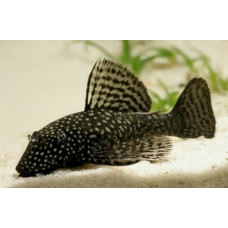Latin name
Ancistrus dolichopterus
Identification
The Bushymouth catfish has a flattened body that is completely covered in polygonal bony plates. Its rounded lower mouth and elongated lips, which have horn-like suction cups, are particularly noteworthy. These features enable the fish to be held firmly in strong currents and to live in fast-flowing waters, where it sucks on rocks and snags. The mouth sucker has horny tubercles designed to scrape plant and animal fouling off the surfaces of plants, rocks, and other objects. In natural conditions, this is their main source of food.
This species of fish can change sex under certain external factors. For example, if there are no males in the aquarium for a prolonged period, one of the females can turn into a male with all the inherent features and qualities (including the ability to fertilise eggs).
They lack a swim bladder and are unable to suspend themselves in the water column like other fish. Therefore, in order to swim any distance without clinging to various objects with their sucker mouths, they are forced to actively use their fins.
Features of fish fins
The torso is equipped with a pair of pectoral and pelvic fins.
Fish colouring
The body of the adult fish is dark brown or greyish, and may contain spots of lighter shades. There are randomly scattered small light dots on the body, which merge into strokes on the fins. The underside is slightly lighter than the dorsal side. The fins are bluish or black with rows of dark spots on the dorsal and caudal fins and vague greyish-blue or olive spots on the pelvic and pectoral fins.
Distribution
It occurs naturally in the Amazon River basin in South America (Guyana, Brazil and Peru).
Habitat
In the habitat of these catfish, the water is relatively fast-flowing and rich in oxygen, and has the following parameters for most of the year: hardness - 4-5 °dH; acidity (pH) - around 6. They prefer shaded areas.
Size
They are one of the smallest species of aquarium catfish. Their size ranges from 8 to 15 centimetres, but the length usually does not exceed 13 cm, even in males.
Behavior
These fish are constantly on the move, usually searching the bottom for remains of living organisms and plant matter. They prefer to stay in the current zone. Males tend to establish and defend a territory. Several males can be kept in the same aquarium if it is large enough and has a variety of shelters. They mostly behave peacefully. If they are not fed regularly, they can become aggressive and carnivorous.
Food and feeding habits
They are very voracious fish. Their lower mouth, lips and teeth enable them to compete with many other species in the same body of water. In search of food, they can climb into the most inaccessible places. Although bushymouth catfish feed on algae on glass, rocks and plant leaves, they should also be given plant food, insect larvae and worms. Adult fish need to be fed regularly, at least twice a day (once at dusk). About 60 percent of their daily diet by weight should consist of various plant foods.
Reproduction
If there are no predatory fish in the aquarium, the fish can reproduce. They can also breed in shelters when living with predatory fish, but the predatory fish will then eat most, if not all, of the fry.
Fish become sexually mature at the age of 8–12 months. The male takes shelter and begins to clean the inner surface intensively with his suction cup. The female remains close by throughout this process. When both are ready to spawn, the female climbs into the tube and lays a number of large eggs, measuring around 2–3 mm in diameter and bright yellow or orange in colour. The male immediately fertilises them. After that, the female leaves the shelter. For 5–6 days, the male guards the eggs, not letting anyone near them. He also swats the eggs with his fins to create an influx of fresh, oxygen-rich water. About six days after spawning, fry up to 5 mm in size hatch, with well-developed suction cups and large yolk sacs. After 1–3 months, the producers are ready to spawn again. They produce about 100 eggs (although different sources give figures ranging from 50 to 300), and productivity depends entirely on the size and age of the female.
Aquarium conditions
The optimal conditions for keeping this species in an aquarium are a water temperature of about 22 °C, a hardness of up to 20–25 °dH and a pH in the range of 6.5–7.5. At least 1/4 of the old water should be replaced with fresh water weekly. Natural driftwood is essential in the aquarium. This promotes intestinal health. Driftwood also serves as a surface for the development of beneficial bacteria and lowers the pH level. It is also important to maintain a correct lighting regime consisting of two evenly spaced phases: dark and light.
| Classification | |
| Phylum | Chordata |
| Class | Actinopterygii |
| Squad | Siluriformes |
| Family | Loricariidae |
| Genus | Ancistrus |
| Species | A. dolichopterus |
| Features | |
| Conservation status | Least Concern |
| Habitat | Bottom |
| Life span, years | 12 |
| Maximum body weight, kg | No information |
| Maximum length, cm | 15 |
| Sailing speed, m/s | No information |
| Threat to people | Not edible |
| Way of eating | Planktonophage |
Bushymouth catfish
Tags: bushymouth catfish



